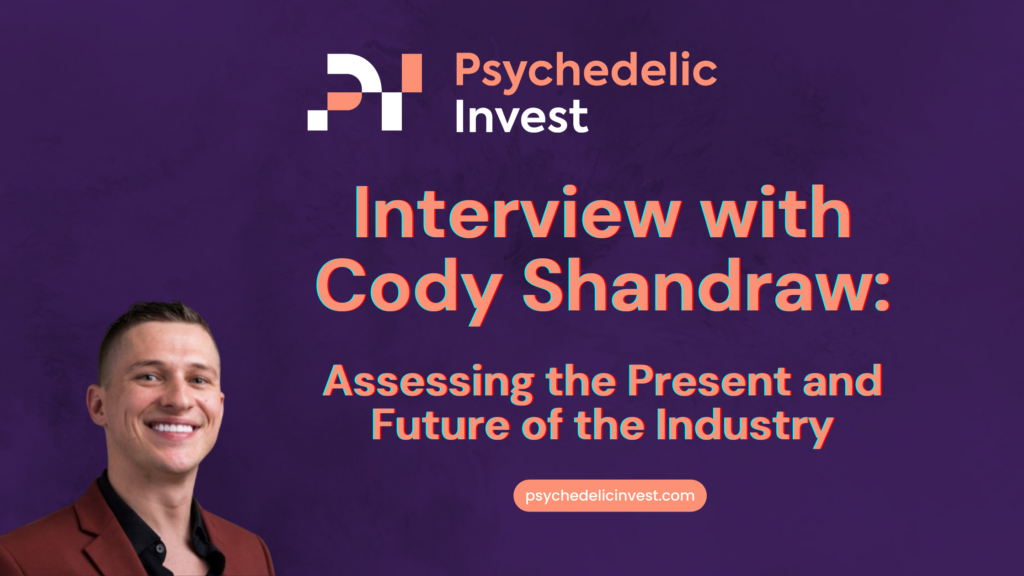Psilocybin
An Interview with Psychedelic Investor Cody Shandraw
Cody Shandraw is a managing partner at Ambria Capital and Co-Founder of Healing REIT, both of which are working to provide better solutions to healthcare….

Cody Shandraw is a managing partner at Ambria Capital and Co-Founder of Healing REIT, both of which are working to provide better solutions to healthcare. Cody’s position gives him a unique view of the psychedelic industry and unparalleled insights.
- Why are you excited about psychedelics?
There are honestly so many reasons to be excited. I think the improved quality of life for millions of people struggling with mental/behavioral indications is what excites me the most. As we see 21 million people suffering from depression alone and the rates increasing year over year, the promise of a new treatment couldn’t be more exciting.
- What do you think the main appeal of psychedelics is for investors?
Billions of dollars have already been poured into this industry, so luckily for any new investors, you will know the real players in each vertical. A lot of the early investors like Iter, Negev, Palo Santo and such have forged the path for what a good investment or investor looks like. The guesswork has been drastically reduced.
- How do you see the psychedelic industry developing over the next ten years?
I see four distinct verticals being developed.
1. The Drug Development Route – Companies creating new chemical entities for specific indications.
2. The Medical Infrastructure – 10s of thousands of clinics will need to be built and or renovated for these new therapies to take place in. Think along the lines of dialysis centers or urgent care clinics, aka treatments moving out of the hospital.
3. The Technologies – Assistance with people pre and post-journeys and follow-ups on their recovery will ease the burden of healthcare workers.
4. The Natural Route – Across states, legislation similar to Oregon’s Measure 109 and Colorado’s Prop 122 is gaining approval, establishing a legal foundation for the immediate accessibility of psilocybin-assisted therapy. In these regions, the utilized medicine remains in its natural form, diverging notably from the synthetic alternatives currently under FDA development. The latter is expected to take an additional 3-4 years before becoming available for therapeutic use, creating a notable time difference in access to these therapeutic interventions
- What do you think will be the most transformative new psychedelic pharmaceutical to the market?
MDMA with MAPS. There are more than 3M diagnosed cases of PTSD every year in the US. We are coming out of a 20-year war in the Middle East, so I’m sure the number will continue to rise. The amount of additional issues created by PTSD for wives, husbands, children, brothers, and sisters of those suffering from it is awful. Right now, there are organizations like No Fallen Heroes (Matthew “Whiz” Buckley) and Heroic Hearts Project (Jesse Gould) doing the work with veterans and psychedelics, but with limited funding, they can only treat so many people.
- Do you anticipate any major hurdles for the industry?
Scaling treatments into existing infrastructure and training will be the biggest hurdles this industry faces, and there isn’t a close second. Look at how well Spravato did this year. Why is that? When Spravato was launched, less than 100 places in the country offered it. Today, there are over 2500 clinics in the US, and the drug is a blockbuster.
- How do you see the underground psychedelic culture coexisting with the emerging pharmaceutical side?
I think there is always going to be a certain demographic that doesn’t trust a “white coat” to provide treatment. Having options to choose the best treatment for you with trusted practitioners inside or outside a clinic is important to me. It doesnt do anyone any good to sling mud at either side of the aisle.

-

 Law & Regulation1 week ago
Law & Regulation1 week agoClearmind signs agreement with Hebrew University for psychedelic compound rights
-

 Psychedelics1 week ago
Psychedelics1 week agoCybin Announces Publication of Research Manuscript in the Journal of Medicinal Chemistry
-

 Psilocybin1 week ago
Psilocybin1 week agoCalifornia advances bill for psychedelics centers
-

 Psilocybin5 days ago
Psilocybin5 days agoPassover Perspectives: Psychedelics, Moses, and the Burning Bush
-

 Psychedelics1 week ago
Psychedelics1 week agoPsychedelics Can Offer More Than Therapy On Its Own
-

 Psychedelics1 week ago
Psychedelics1 week agoRevive Therapeutics Announces FDA Acceptance of Meeting Request for Long COVID Diagnostic Product
-

 Psychedelics4 days ago
Psychedelics4 days agoAlgernon NeuroScience and the Centre for Human Drug Research to Present DMT Phase 1 Stroke Clinical Data at the Interdisciplinary Conference on Psychedelic Research June 6 – 8th, 2024
-

 Psychedelics5 days ago
Psychedelics5 days agoRevive Therapeutics Announces Type C Meeting Request Granted by FDA for Clinical Study of Bucillamine to Treat Long COVID








